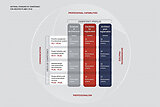The 2021 NSCA describes what is reasonably expected of a person who can demonstrate the standard of skill, care and diligence widely accepted in Australia as a competent professional architectural practitioner.
The 2021 AACA National Standards of Competency for Architects can be found here.
The 2021 NSCA sets out the benchmark against which an applicant for registration as an architect in Australia is measured.
Embedded within the practice of architecture is the recognition of Aboriginal and Torres Strait Islander Peoples’ ongoing connection and custodianship of Country, and the ethical responsibilities to the physical environment and the transition to a carbon-neutral built environment. These responsibilities are fundamental to architecture practice.
Architectural design – a creative endeavour combined with the capacity to realise and deliver built projects – is at the core of the profession of architecture. The NSCA sets out a clear roadmap for the development and assessment of competency at key milestones over the course of a career in architecture – from graduation, through the registration process, to ongoing practice after registration. This is inclusive of a range of practice models and career paths.
The three main components of the NSCA are Professional Capabilities, Competency Profiles and Units of Competency, which are assessed through associated Performance Criteria. These integrate to form a cohesive system that supports the development of professional competency over time.

